Physical Address
304 North Cardinal St.
Dorchester Center, MA 02124
The presence of a neoplasm in bone is manifested in a variety of ways. Pain and localized swelling or pathologic fracture are the most frequent presenting complaints, but rarely is a bone tumor discovered as an incidental finding on radiographic images made for other reasons (e.g., after trauma). Occasionally, the appearance of new symptoms or a changing clinical picture in the presence of a known skeletal disorder may signal the onset of malignant transformation in a benign precursor lesion.
Early diagnosis of bone neoplasms is complicated by the fact that except for osteoid osteoma and the extremely uncommon intraosseous glomus tumor, small bone tumors are usually asymptomatic. Primary malignant tumors of bone generally reach substantial dimensions before they produce symptoms (predominantly pain or pathologic fracture).
Although the majority of primary bone malignancies arise de novo, it is increasingly apparent that some develop in association with recognizable precursors. The likelihood of discovering these associated lesions can be facilitated by attention to clinicopathologic correlation of all available data before arriving at a diagnosis. In bone, the inclusion of radiographic imaging data in the diagnostic process offers a unique opportunity to discover clues to causal relationships that may not be reflected in histologic patterns or in other laboratory data. This is especially true when serial radiographs are available for review.
Paget's disease, radiation injury, and some of the more common benign cartilaginous dysplasias are the most clearly established precancerous conditions. The relative rarity of malignant transformation in fibrous dysplasia, osteomyelitis, bone cysts, osteogenesis imperfecta, and bone infarction places these conditions in a separate category. The possible relationship of secondary malignancy to metallic implants and joint prostheses is a subject of increasing concern, although its statistical validity is still in doubt. Additional neoplastic and nonneoplastic lesions that may be precursors of malignancy in bone are listed in Table 24-1 . In this chapter the discussion of precancerous lesions is limited to those conditions that play a major role in increasing the risk for bone malignancy.
| Nonneoplastic Conditions | Benign Tumors |
|---|---|
| Paget's disease * | Osteochondroma (see Chapter 6 ) |
| Chronic osteomyelitis * | Enchondroma (see Chapter 6 ) |
| Bone infarct * | Ollier's disease and Maffucci's syndrome (see Chapter 6 ) |
| Metallic implants * | Chondromyxoid fibroma (see Chapter 6 ) |
| Radiation, osteitis * | Giant cell tumor (see Chapter 10 ) |
| Osteogenesis imperfecta * | Metaphyseal fibrous defect (see Chapter 8 ) |
| Fibrous dysplasia (see Chapter 8 ) | Osteoblastoma (see Chapter 4 ) |
| Bone cysts (see Chapter 15 ) | Osteofibrous dysplasia and adamantinoma of long bones (see Chapters 8 and 17 ) |
| Synoval chondromatosis (see Chapter 20 ) |
Osteitis deformans, as described by Sir James Paget, represents a prototype skeletal disorder that predisposes to the development of sarcoma in bone. A comprehensive description of this unique disease is beyond the scope of this book; thus the discussion of Paget's disease is restricted to the basic clinicopathologic features of osteitis deformans that are relevant for its recognition when it is associated with sarcoma of bone. From the pathogenetic point of view, the disease can be explained by increased transient but progressive and multifocal osteoclastic activity, with bone resorption followed by new bone formation, and ultimately bone sclerosis.
Ultrastructural and immunohistochemical analyses have demonstrated cytoplasmic and nuclear inclusions in the osteoclasts of pagetic bone that are similar to those seen in paramyxovirus infection. As a result of these observations, some authors support the hypothesis that Paget's disease may be induced by a slow viral infection. When there is a high rate of bone turnover with rapid bone growth, cell proliferation, and osteoclastic activity, it is conceivable that somatic mutations and genomic deletions will occur with a high frequency and thus provide a molecular basis for malignant transformation. Other authors have alluded to the possibility that an infectious etiology is a cofactor in the development of malignancy in Paget's disease. However, more recent attempts to identify paramyxovirus coding sequences by the use of polymerase chain reactions have failed to demonstrate the presence of a paramyxoviral genome in Paget's disease. Modern concepts postulate that the etiology of Paget's disease is heterogeneous and involves both genetic and environmental components ( Fig. 24-1 ). The gene with mutations in the coding region associated with Paget's disease is sequestosome 1 ( SQSTM1 ) encoding the p62 protein. All mutations involving p62 identified in Paget's patients cause the loss of function of the C-terminal ubiquitin-associated (UBA) domain. These mutations result in elevation of NFκB in pagetic osteoclastic cells but are insufficient to induce full pagetic phenotype, and additional genetic as well as environmental factors are needed for full expression of the pagetic phenotype. The scaffold p62 protein has specific interactions that mediate activations of RANKL, a key regulator of osteoclast function. The most common mutation, SQSTM1 C1215T , causes amino acid substitution and is found in approximately 10% of sporadic and 30% of familial Paget's disease. Recently, SQSTM1 mutations have been identified in patients with amyotrophic lateral sclerosis and frontotemporal lobar degeneration, neurodegenerative disorders in which there is previously unrecognized coexistence with Paget's disease of bone. The mutations in these disorders can overlap with those identified in Paget's disease, but some of them appear to be specific for the neurodegenerative disease. These findings provide an unexpected link between amyotrophic lateral sclerosis/frontotemporal lobar degeneration and Paget's disease of bone.
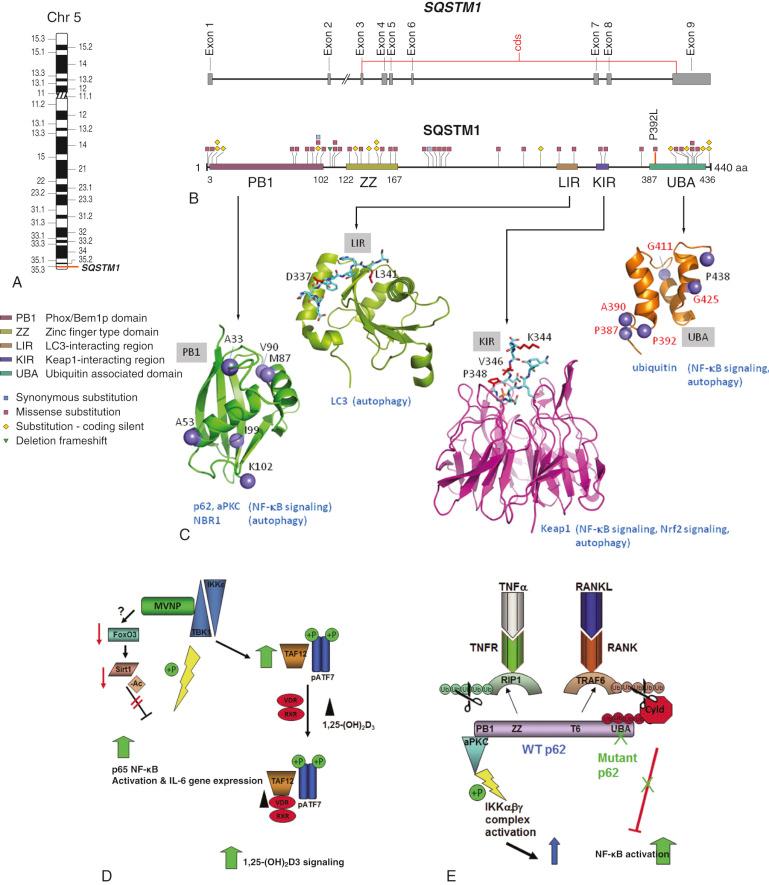
The genetic linkage studies have identified seven predisposing loci that involve 1p12.3 (macrophage colony stimulating factor [M-CSF; CSF1 ]), 18q21.33 (RANK [ TNFRSF11A ]), 8q22.3 (dendritic-cell-specific transmembrane protein [ DCSTAMP ]), 10p13(optineurin [ OPTN ]), 7q33 (nucleoporin 205κDa [ NUP205 ]), 14q32 (Ras and Rab interactor 3 [ RIN3 ]), 15q24 (promyelocytic leukemia [PML] and golgin A6 family, member A [ GOLGA6A ]). The environmental factors that are suggested as possible contributors for Paget's disease include dietary deficiencies (calcium and vitamin D), chronic infection with measles virus, canine distemper virus, and respiratory syncytial virus. The potential contribution of chronic infections with measles virus has been the most extensively studied. In animal models, the expression of measles virus nucleocapsid gene (MVNP) in osteoclasts induces pagetic lesions. The overexpression of MVNP in osteoclastic cells activates NFκB and results in increased levels of IL-6 and ephrinB2. This, in turn, elevates ephrinB4 in osteoblastic cells, leading to the increased bone formation implicated in the development of pagetoid sclerosis. These new molecular developments provide interesting clues to the pathobiology of Paget's disease, but full understanding of this complex and still mysterious disorder is far from complete.
Paget's disease is widespread in many countries. Autopsy data indicate that it can be found in 3% to 4% of unselected patients older than age 45 years who died of various causes. The rate of radiographically diagnosed Paget's disease varies from 1 in 500 to 1 in 12,000 hospital admissions. It appears that male and female patients are almost equally affected by the disease, but in many series, the incidence is slightly higher in men.
Paget's disease is common in Europe. The incidence is highest in the United Kingdom, France, and Germany. It is less frequent in Scandinavia, Spain, Italy, Central Europe, and Russia. The incidence in Australia and New Zealand is similar to that in Great Britain. Families with several generations affected by Paget's disease have been described. The rate of familial variants is unclear, and most authors report that less than 10% of cases have a familial pattern. A mendelian-dominant pattern of transmission has been documented in some families.
The onset of Paget's disease is insidious, and the disease can be asymptomatic for many years. The full clinical picture with characteristic bone deformities appears after 20 to 30 years. Cases with widespread involvement of the skeleton and characteristic deformities are rare. It is estimated that there is 1 such case per every 100 patients with indolent asymptomatic disease. The disease is rarely diagnosed in people younger than age 40 years. The disease in its fully developed clinical picture is typically seen in patients in the sixth through eighth decades of life.
The typical skeletal deformities of fully developed Paget's disease consist of an enlarged head, outward bowed femora, forward bowed tibiae, and bowed back. The long bones appear to be thickened on external examination. A single bowed and enlarged long bone, such as the tibia or femur, may be the only clinical sign. In most such cases, a radiographic examination documents the involvement of additional bones. Clinically silent Paget's disease is most frequently identified on radiographs of the pelvis, sacrum, and lumbar spine. In general, the spine, pelvis, skull, and femur are considered the most frequently affected parts of the skeleton ( Fig. 24-2 ). The tibia and the humerus are less frequently affected.
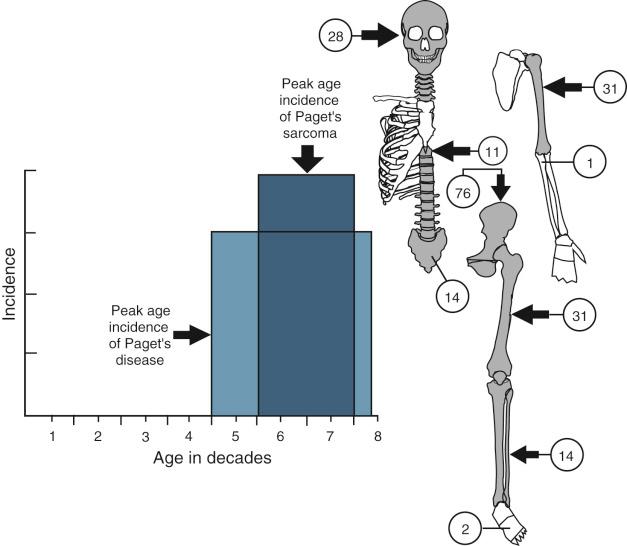
Radiographically, the lesions present as areas of irregular increased density with a cotton wool–like appearance interspersed by radiolucent areas ( Fig. 24-3 ). More consolidated and larger areas of sclerosis can also be present. The bones are usually enlarged, and their normal shape or contour is altered by the development of prominent bony deformities ( Fig. 24-4 ). In the long bones, the disease typically starts within the end portion and progresses toward the shaft ( Fig. 24-5 ). When the disease is confined to the epiphyses of long bones, it can be confused on radiographs with other conditions such as giant cell tumor. Radiolucent areas represent younger, active foci. Patchy sclerosis is the intermediate phase. More consolidated larger areas of sclerosis represent the final stages of the process. Early lesions of the skull represent well-demarcated circular lytic areas, referred to as osteoporosis circumscripta ( Figs. 24-6 and 24-8 ). Characteristically, in areas with paired bones such as the forearm or leg, only one bone is altered ( Fig. 24-7 ). The other bone either is intact or shows only minimal involvement. Bowing deformities and pathologic fractures are typically seen in weight-bearing sites.
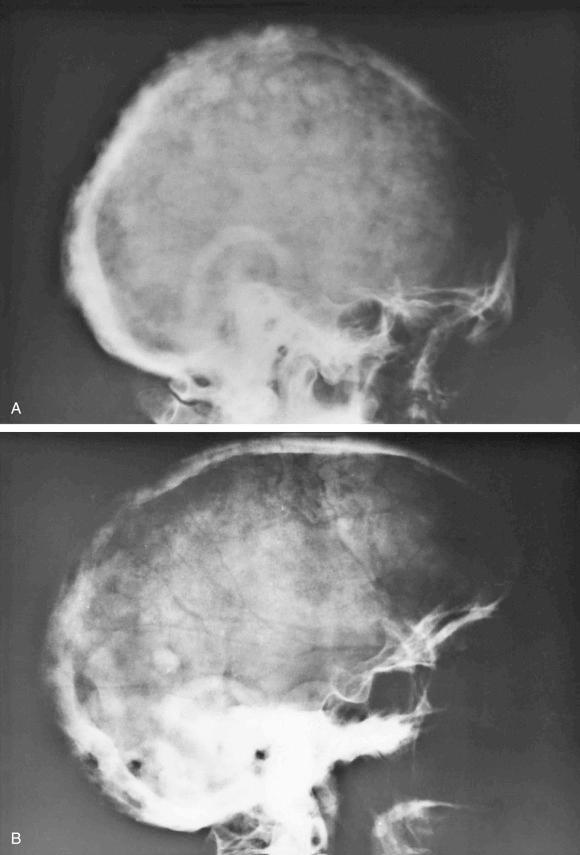
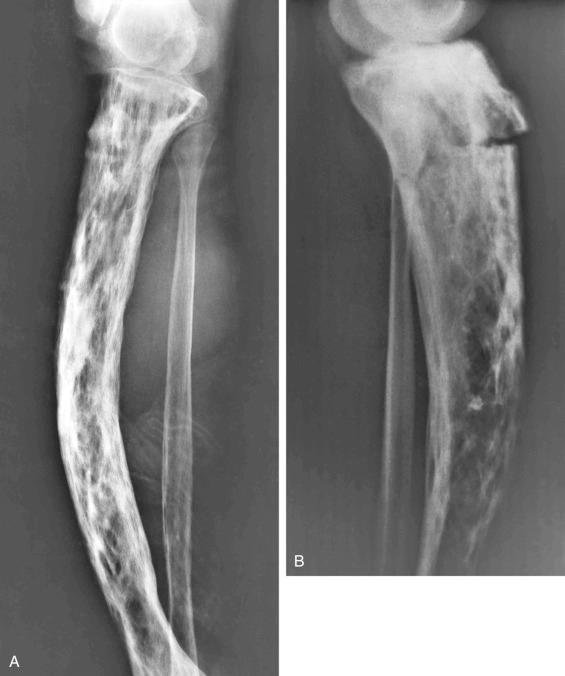
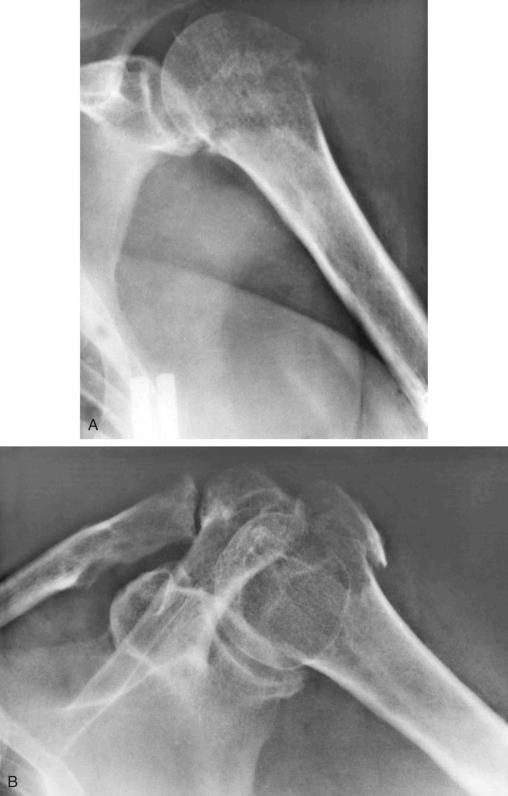
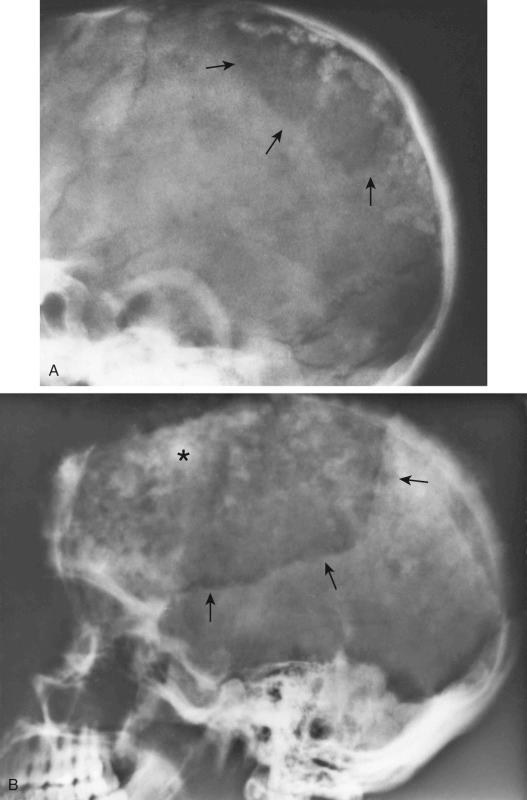
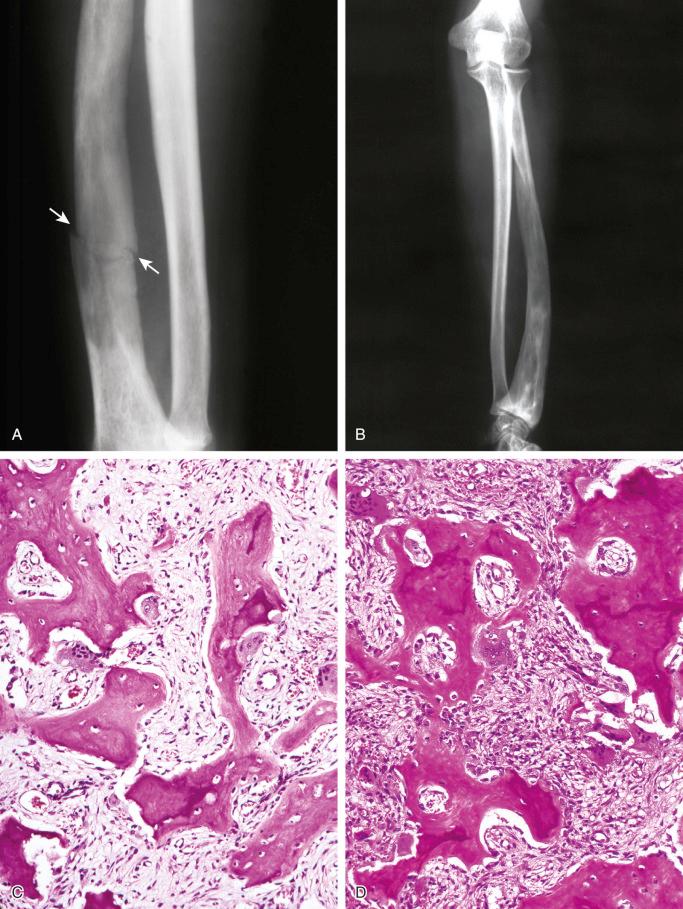
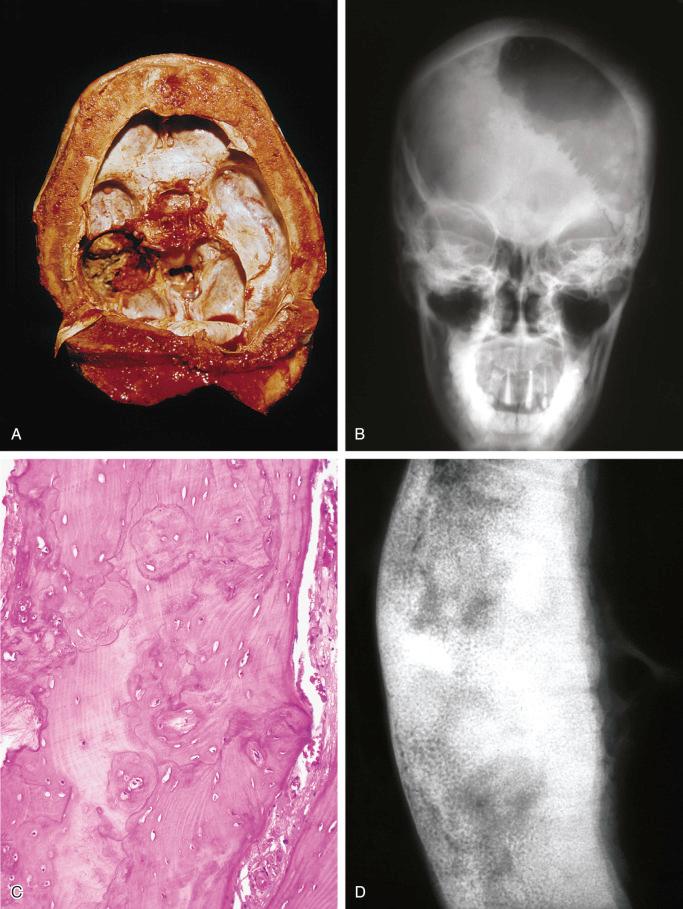
Microscopically, the initial early phase of the disease shows increased osteoclastic activity with fibrosis and prominent vascularization of the intertrabecular spaces. The fully developed, active phase of Paget's disease is a mixture of osteoclastic activity that may lead to the formation of large clusters adjacent to Howship's lacunae ( Fig. 24-9 ). In addition, prominent osteoblastic activity results in the production of new osteoid. Bone in Paget's disease represents irregular trabeculae with scalloped contours and irregular lines of mineralization that mimic a mosaic pattern. The end of the last phase is dominated by large areas of bone sclerosis in which multiple irregular lines of mineralization are present. Typically, different phases of the disease are present in different areas of the affected bone ( Figs. 24-9 to 24-11 ).
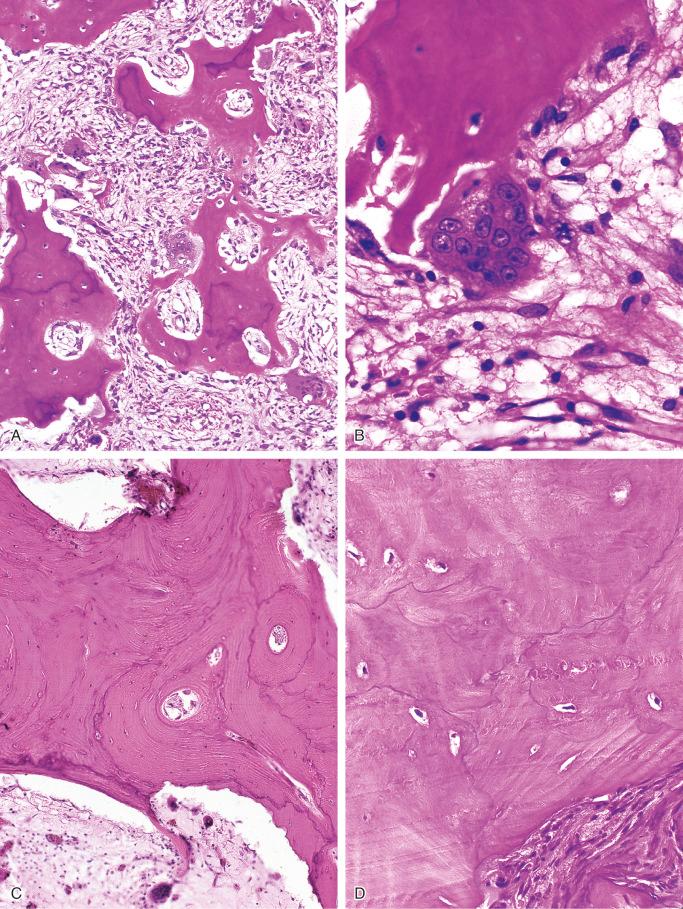
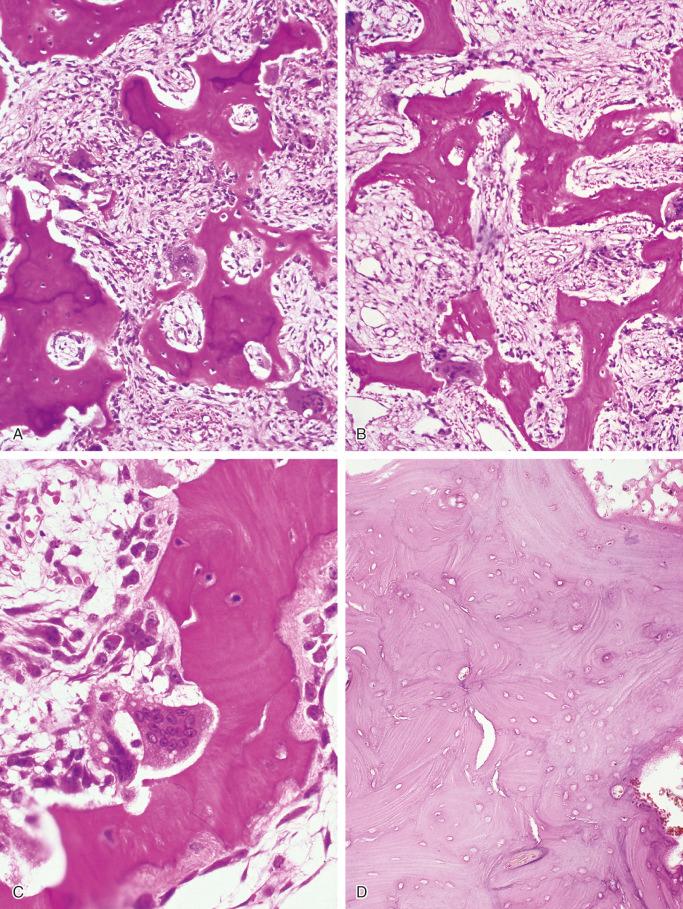
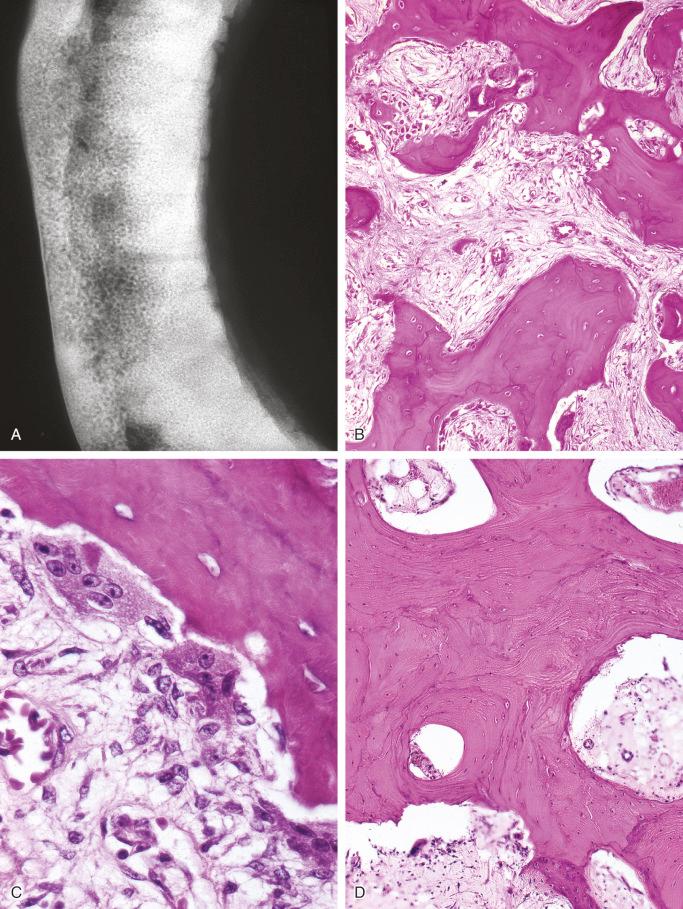
The development of bone sarcoma in this condition is the most serious complication and, although uncommon, accounts for 20% of the bone sarcomas occuring in patients older than age 40 years. The incidence of Paget's sarcoma increases steadily with age until the seventh decade of life, and the rate of sarcomatous transformation ranges between 1% and 10% depending on the extent and severity of the disease. Data from the Surveillance, Epidemiology, and End Results program confirm this epidemiologic pattern of incidence and show that the overall incidence rate of Paget's sarcoma is approximately 0.1 to 0.2 per 100,000. In patients older than age 50 years, it is significantly higher and varies from 0.4 to 0.7 per 100,000. Because so many cases of Paget's disease are asymptomatic, the interval between onset and the development of a sarcoma is uncertain. Sarcoma complicating Paget's disease is typically diagnosed in patients older than age 50 years. Clinically, the most common presenting symptoms are a progressive increase of localized pain and a palpable mass; less often, a pathologic fracture is the first symptom. Serum levels of alkaline phosphatase can be increased compared with previous levels. The sites most frequently involved by sarcomatous changes are the pelvis, humerus, and femur. Overall the distribution of sarcomatous changes parallels the distribution of skeletal sites involved by the disease (i.e., the bones frequently altered by Paget's disease are likely to develop sarcomatous transformation) ( Fig. 24-2 ). Typically the bone involved by sarcoma also exhibits both the radiographic and gross features that are characteristic of Paget's disease ( Figs. 24-8 and 24-12 ).
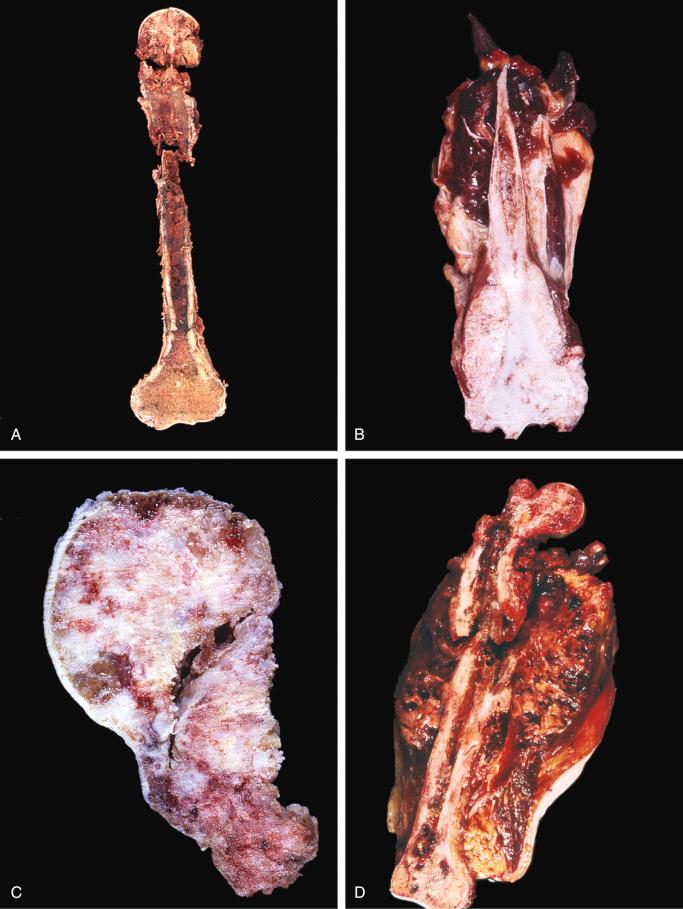
Radiographically, the predominant tumor pattern is osteolytic. Mixed and osteoblastic patterns occur less frequently. Cortical breakthrough without periosteal reaction and bulky extension into soft tissue are other signs of malignancy ( Figs. 24-13 and 24-14 ). Computed tomography and magnetic resonance imaging may be more sensitive for the early detection of sarcomatous degeneration.
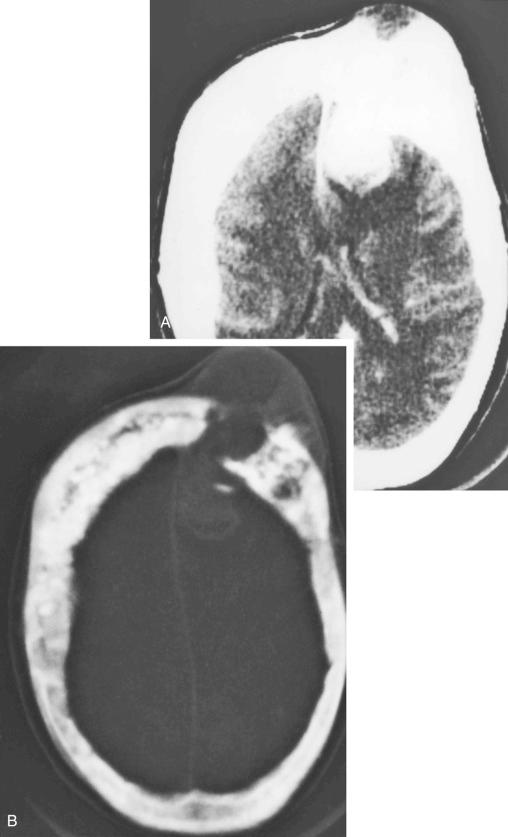
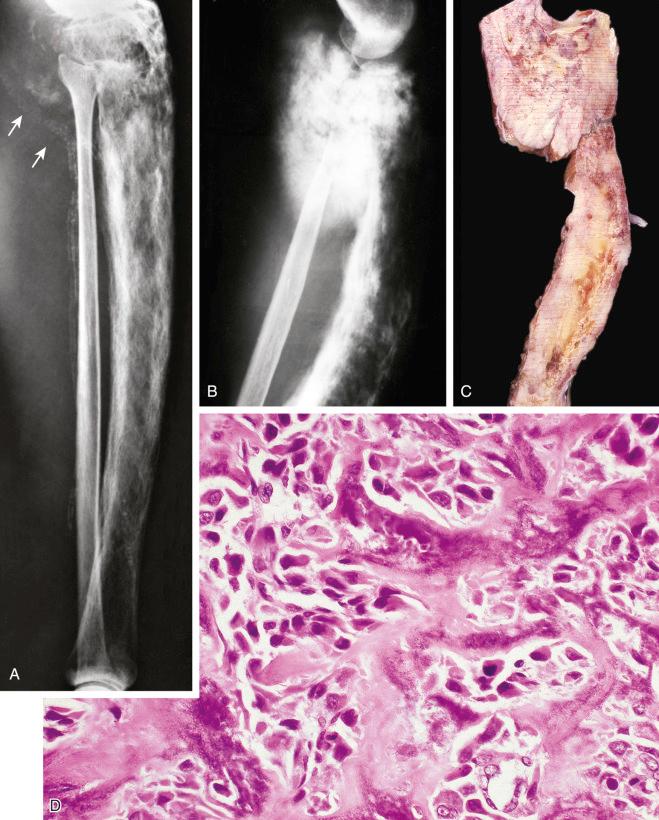
The most common histologic type of Paget's sarcoma is osteosarcoma ( Figs. 24-15 and 24-16 ), although fibrosarcoma, chondrosarcoma ( Fig. 24-17 ), malignant giant cell tumor, and malignant fibrous histiocytoma can also occur. Because of the variability in histologic patterns, some authors designate these tumors only as Paget's sarcomas.
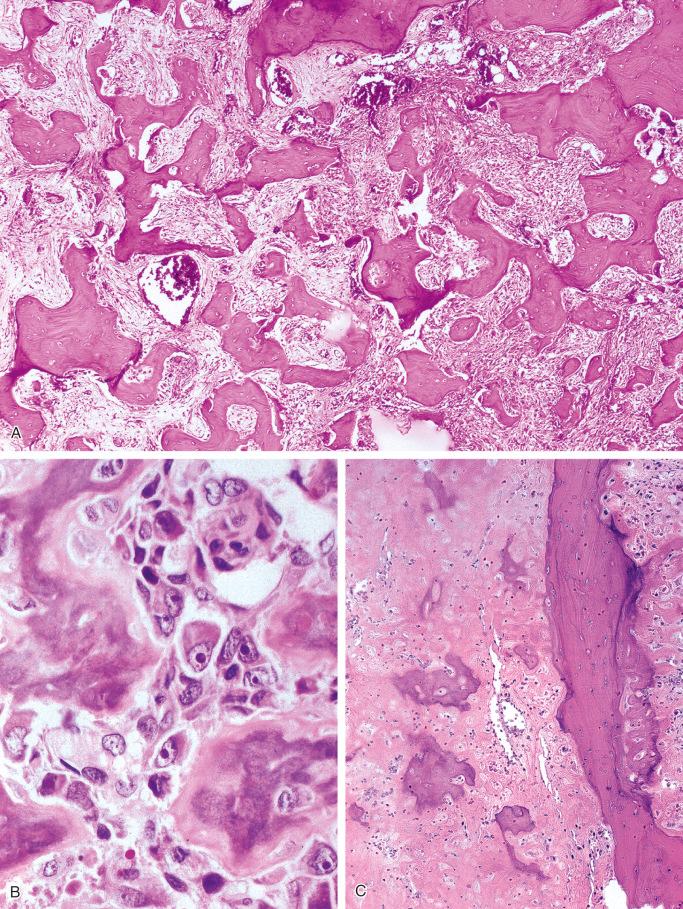
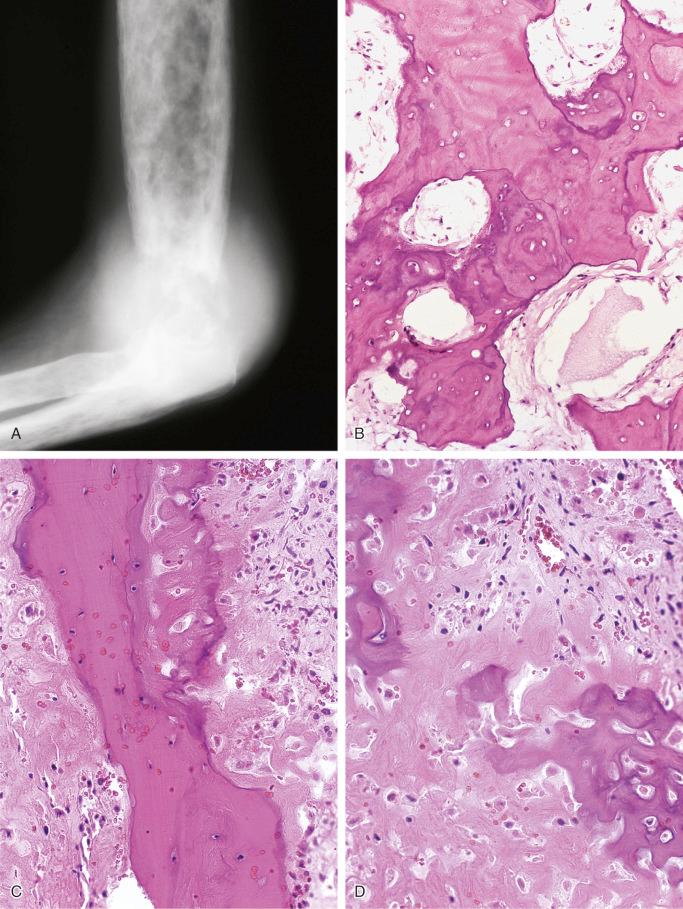
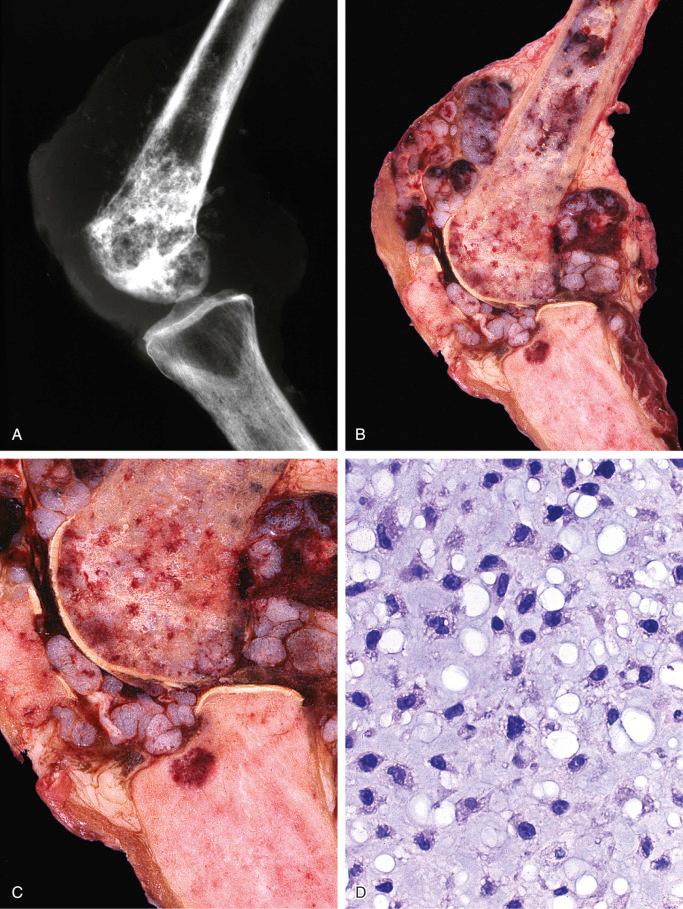
The prognosis is poor for the majority of patients. The 5-year survival rate for osteosarcoma is 8% compared with the current 50% to 65% 5-year survival rate for de novo osteosarcoma. In addition to the higher grade of the tumors, the fact that these patients are in an older age group that is typified by decreased immunity, poor general health, and low tolerance for conventional chemotherapy and radiotherapy may account for this discrepancy. In addition, the unusual anatomic location of the tumors, such as the axial skeleton and craniofacial bones, accounts for the difficulty in treatment by complete resection. The most frequent cause of death is distant metastasis. Multicentric Paget's sarcoma has been described and interpreted by some as metastases; others believe that each site is a separate primary tumor.
Benign giant cell tumors have also been described in association with Paget's disease (see Chapter 10 ). The most common locations for these tumors are the skull and facial bones, and although benign, such tumors can be locally destructive and extend into soft tissues. The tumors may have the histologic appearance of giant cell tumors of bone, but some authors have emphasized the resemblance to giant cell reparative granuloma. Many patients with these types of tumors have a common ancestry from Avellino, Italy. It is still not clear whether genetic factors, environmental factors, or both play a role in the link between patients and the development of this unusual neoplasm.
Long-standing inflammation with intermittent sinus tract formation in chronic osteomyelitis and reactive hyperplasia of the squamous epithelium provides the setting for malignant transformation in approximately 0.5% of patients affected by this condition. Therefore the risk of malignant transformation in chronic osteomyelitis is relatively small. The tibia is most frequently affected by chronic osteomyelitis and consequently is the typical site of secondary malignancy in this setting ( Fig. 24-18 ). A tumor mass or an ulceration with indurated borders typically develops within the sinus tract and may extend down into the bone ( Figs. 24-19 and 24-20 ). Less frequently, squamous cell carcinoma develops in the epithelialized lining of the bone defect.
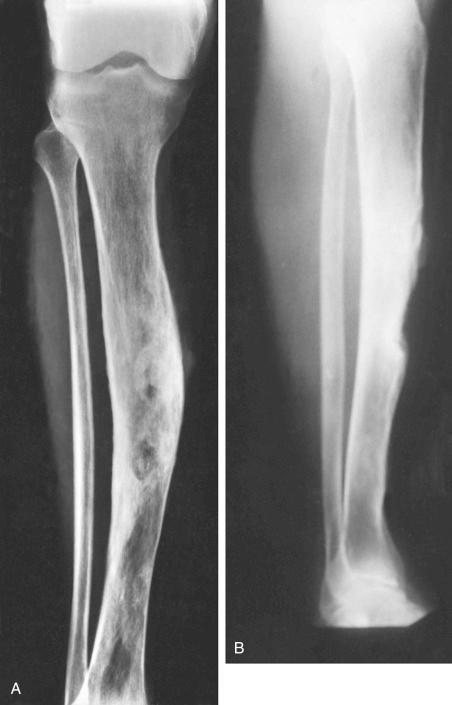
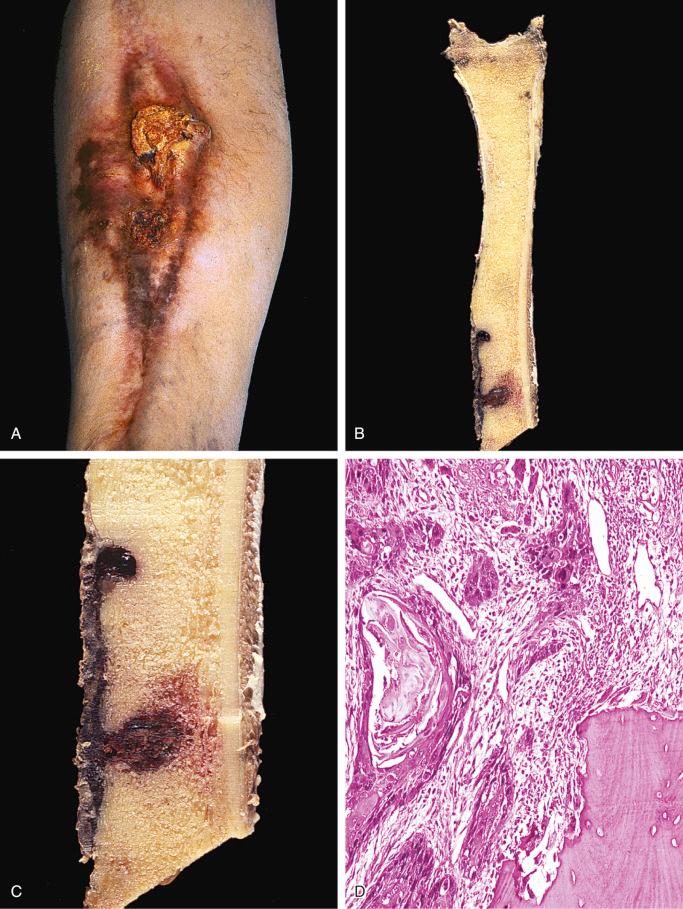
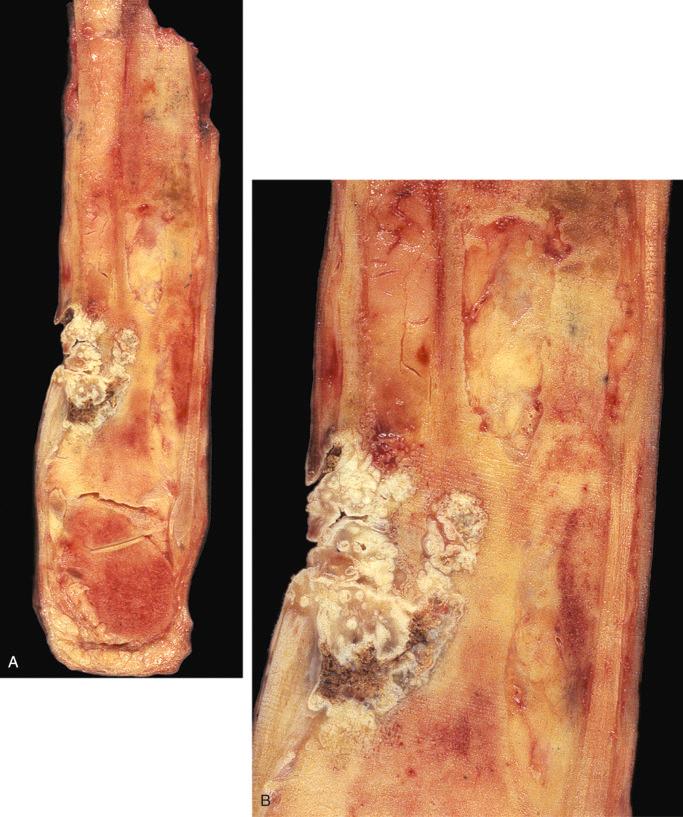
Atypical pseudoepitheliomatous hyperplasia heralds the transformation into squamous cell carcinoma. Sometimes it is difficult to separate the two conditions in the limited, small, and superficial biopsy material. Differential diagnosis between florid pseudoepitheliomatous proliferation and well-differentiated squamous cell carcinoma is the common problem in evaluating sinus tract biopsy specimens from patients with chronic osteomyelitis ( Figs. 24-21 and 24-22 ). Some authors advocate amputation as an appropriate treatment for both conditions; it is followed by evaluation of large tissue sections from postoperative material to distinguish between the two conditions with certainty. Regional lymph nodes are often enlarged as a reaction to the inflammatory process, but metastasis occurs in only 10% to 20% of cases. However, this rate is high enough to require that the surgical approach must include lymph node biopsies. Tumor histology and regional lymph node involvement are related to survival. Pulmonary and visceral metastases are exceedingly rare in this form of secondary malignancy.
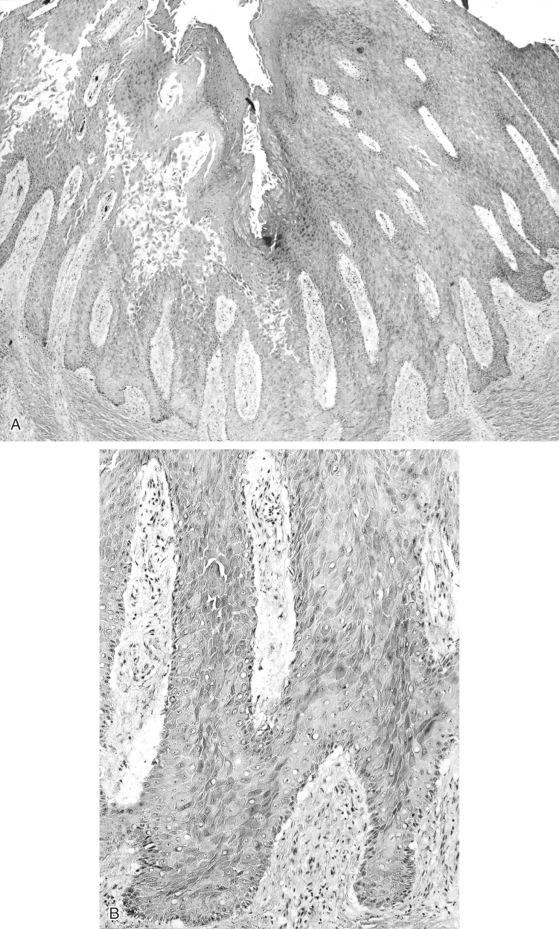
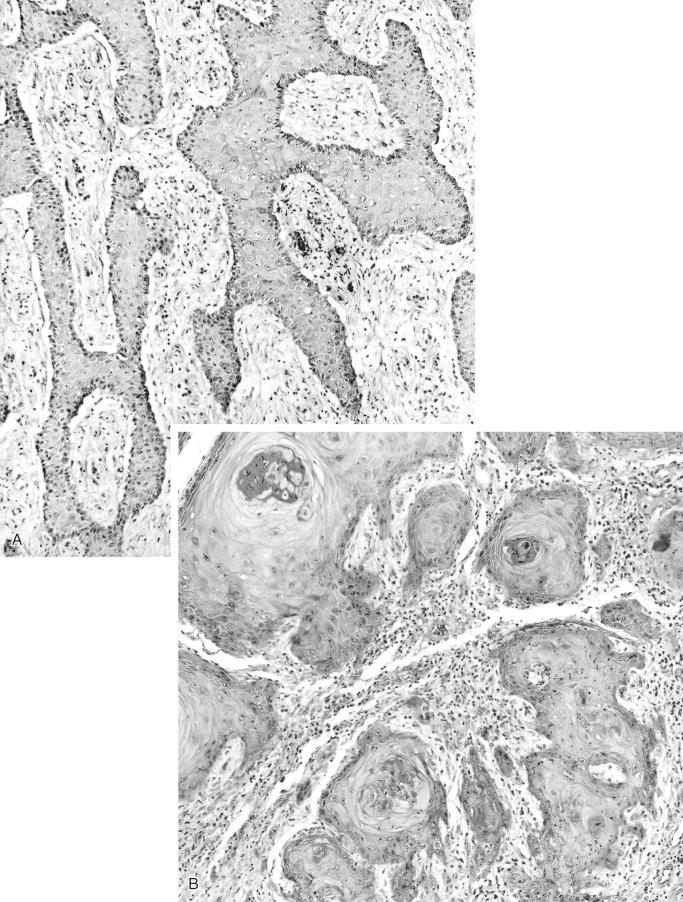
Squamous cell carcinoma is the most common type of malignant tumor that evolves at the site of chronic osteomyelitis, and the latency period is between 20 and 50 years. The lower extremities, in particular the tibial region, are most commonly affected.
Clinical signs that should arouse suspicion about malignant transformation include increased pain with foul or bloody discharge from the sinus, a progressively enlarging mass in and around the sinus tract opening, and progressive bone destruction.
Multiple biopsies are advisable for adequate assessment of the affected tissues. The histologic features of malignancy include cellular atypia, abnormal mitosis, lymphatic permeation, and invasion into blood vessels. Abnormal maturation patterns that show formation of squamous pearls deep within the infiltration tongues of squamous epithelium help distinguish squamous carcinoma from pseudoepitheliomatous hyperplasia ( Fig. 24-23 ). The diagnostic difficulties are amplified by the irregular shapes of the fistulous tracts, which cause the squamous lining to be cut tangentially on histologic sections. Moreover, squamous cell carcinomas that develop in sites of chronic osteomyelitis frequently tend to be moderately to well-differentiated lesions that on small biopsy samples can easily be confused with benign squamous epithelium proliferation.
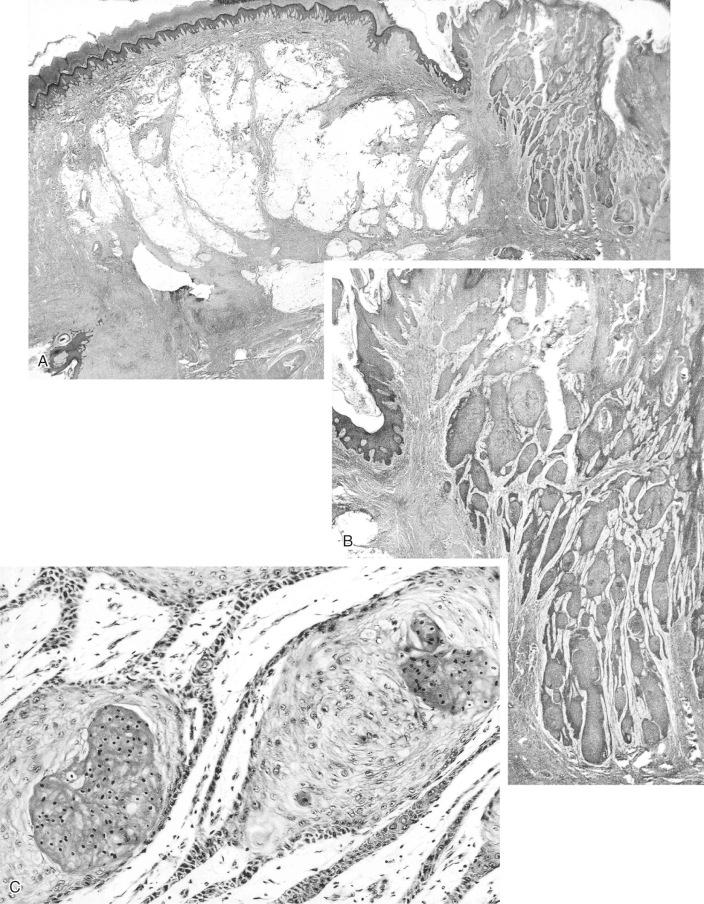
In addition to squamous cell carcinoma, other tumors have been described in association with osteomyelitis. These include basal cell carcinoma, adenocarcinoma, myeloma, fibroblastic osteosarcoma, angiosarcoma, rhabdomyosarcoma, and lymphoma. Because the sarcomas metastasize in 56% of cases, they have a worse prognosis than that for secondary carcinoma.
Become a Clinical Tree membership for Full access and enjoy Unlimited articles
If you are a member. Log in here